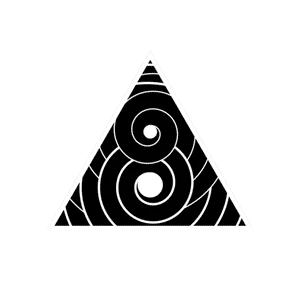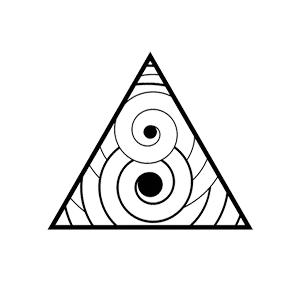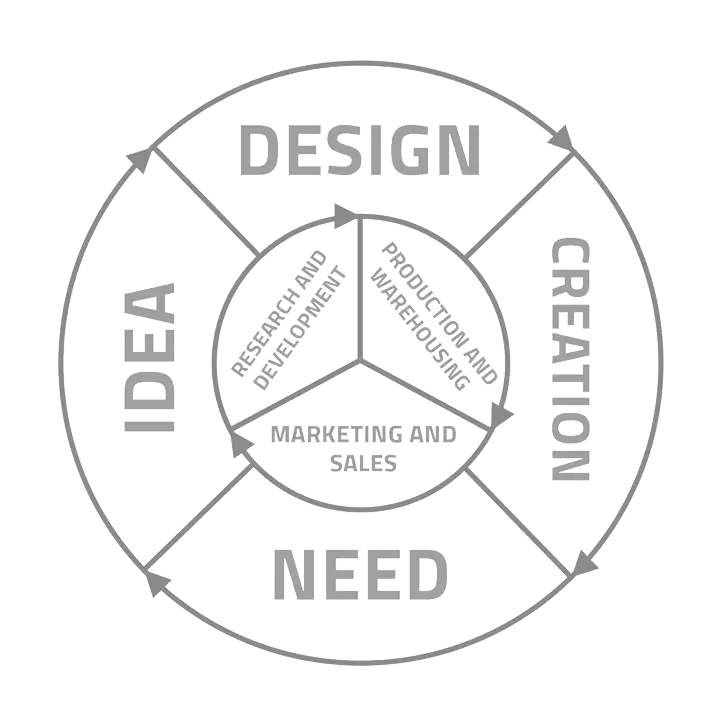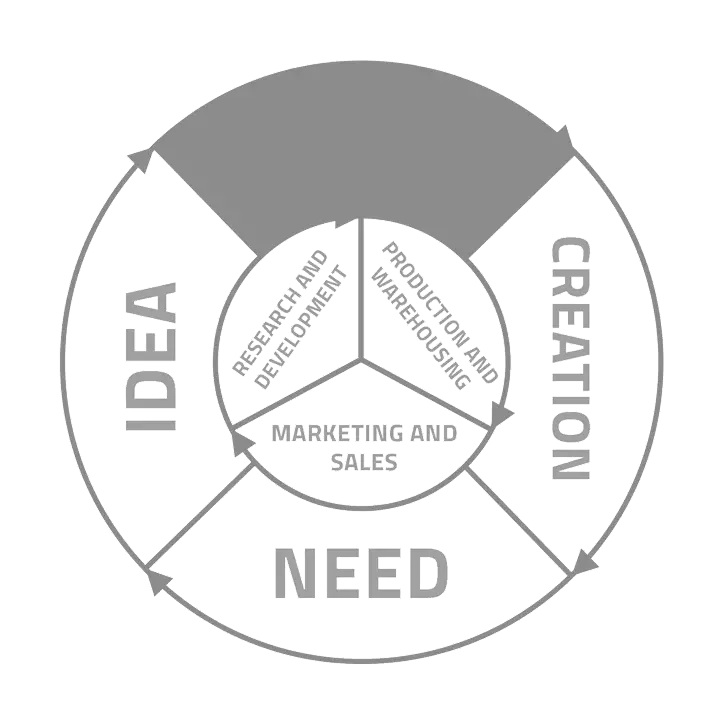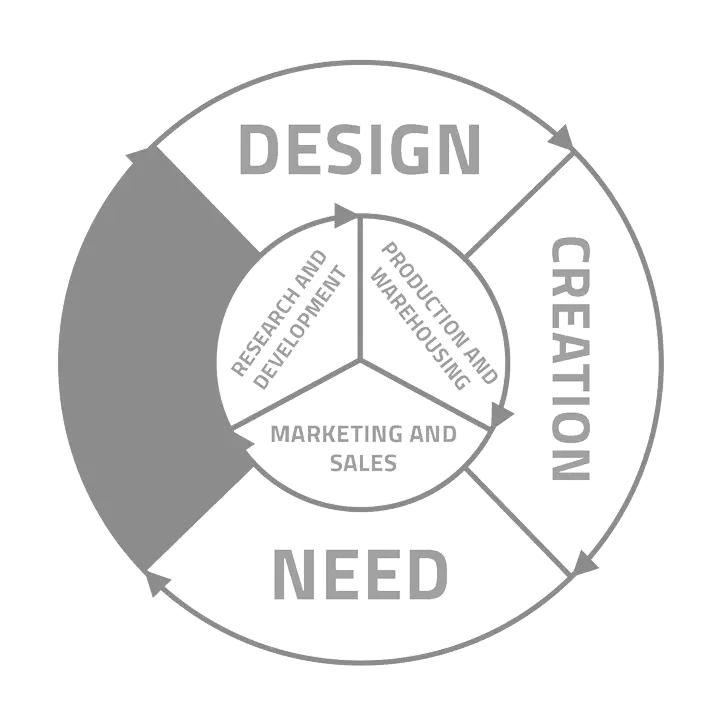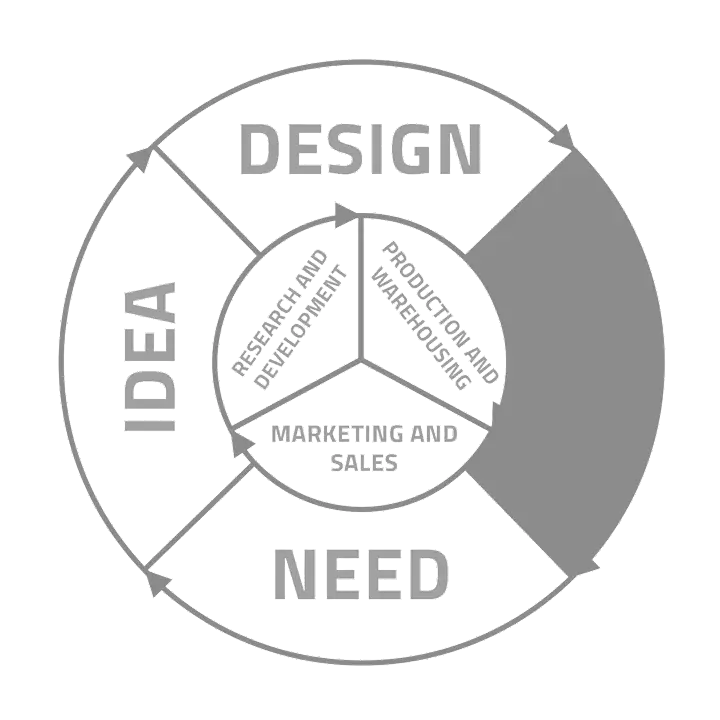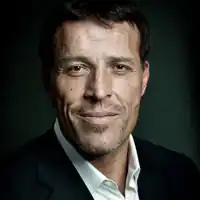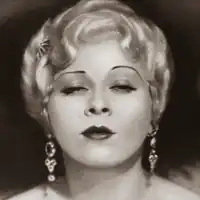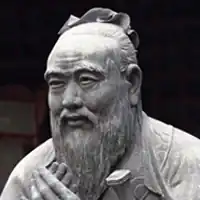the cycle
of the need
and design process
In this section, we will explain the needs cycle, and design process of our team
Introduction
In this article, we will explain the concept of the need cycle. As the human population on the planet increases, meeting needs in the right way and at the right time is essential for optimization and survival. Otherwise, we will face serious problems. These needs can range from the most basic human needs to the customer’s needs that can be fulfilled by a manufacturer or service provider. We will examine why some needs are not met properly and what are the consequences and costs of an incomplete cycle.
need cycle
The four main elements of this cycle are:
Review
This article will describe the industry’s need cycle and the problems caused by missing crucial elements. The cycle starts with the customer’s need for a product or service. The market research team identifies these needs and potential solutions with the help of the ideation team. The ideation and design teams develop and illustrate the ideas and create a comprehensive plan.
Then, the design and production teams model the final design according to the production constraints, available facilities, and usable technology and prepare the final studies. At this stage, the production team produces the final design, and the sales team delivers the final product to the customer with the help of the production team.
result
As we know, people in different parts of the world have unique tastes and preferences based on their climate, conditions, and lifestyle. They also have different needs according to those factors. Throughout history, these tastes and needs have been expressed in various designs, patterns, and roles in people’s lives. This can be seen in our country, Iran, in many aspects. Our country has a long and rich history of designs and patterns that can be found on our carpets, walls, tiles, paintings, products, structures, etc.
Indeed, people who live in a region that experiences four seasons with different climates will have different tastes and needs from those who live in a country that is always cold or a country that is always cloudy and has little sun. For example, a large size Chinese dress is considered small in Germany. Or in China, Japan, and some other countries, people use chopsticks for eating most foods according to their customs and conditions. But we and many other countries prefer spoons and forks.
Suppose an Iranian manufacturer with an incomplete cycle and no design chooses a product from Canada and copies its design to produce it. As a result, this manufacturer not only violates the designer’s rights and steals the design of that team but also produces products for Iranians whose shapes, surfaces, and uses are suitable for a cold environment.
Or suppose the same producer has a cycle without ideation. In this case, it produces products for its country designed to meet the needs of a Canadian, not an Iranian. In this case, it may meet some of the needs of an Iranian, but certainly not all of them.
Unfortunately, some producers in our country directly import old products from the production line of other countries to save time and costs and achieve quick profits.
The idea and design of those products were unsuitable for an Iranian, nor was any Iranian involved in making them, such as mold makers, material suppliers, machine makers, and other parts. Many of these producers import an old joint product and need help from the intellectual property center of our country.
Because of that, they have wasted their money and time on a corrupt and inefficient shortcut.
According to the explanations and the study of more details, we can remove the existing obstacles and try to complete this cycle in different parts of industry, production, and trade by providing optimal methods and solutions. In future articles, we will detail this cycle and have a closer look by giving an example.
design process
Stage 01
The quality of the project’s output and the efficiency of the project management depend mainly on the accuracy and comprehensiveness of the input data. It also helps to avoid delays and revisions.
The following key points are essential for the input data, but they may not be exhaustive:
-
Detailed descriptions of the ideas in written or sketch form
-
Sample of similar products if there is a history available
-
Limitations and critical dimensions of the product
-
Deadlines for each milestone of the project
-
Estimated budget for the project
-
Target market’s needs and preferences for the product
-
Future vision of the product and branding strategy
-
Expectations from our team and the designed product
stage 02
We start sketching ideas based on the input data and product research. Our team will offer digital sketches of two or three different designs from various hand sketches we have done.
Some of the aspects that We take into account are:
-
Aesthetics
-
Choosing the best way to protect the environment
-
Revisiting the target market to align the design with the current market demands
-
Considering the latest technology for enhancing product performance and quality
-
Selecting the appropriate materials for each product component and evaluating their constraints
-
Optimizing the product design by reducing the number of components and their weight, which lowers the project cost and material consumption
-
Improving the user experience by considering the ergonomics and mechanical details of the product
-
Analyzing the production and assembly process for potential efficiency gains
-
Cutting down the cost by reexamining the product storage conditions and transportation methods
stage 03
Our chosen sketch will be transformed into a simple 3D model, which will be enabled us to understand the process better and refine our sketch closer to the final design. We also create digital hand-drawing improvements on renders to enhance the quality.
This model has the specifications for making a prototype.
stage 04
We create a detailed 3d model of the chosen design according to the manufacturing methods. We have extensive knowledge of plastic, steel, sheet metals, wood, and prototype materials. Also, have broad experience in production methods such as injection molding, blow molding, vacuum forming, metal casting, progressive stamping, and CNC machining. We transform your idea into a product.
For instance, in plastic-made products, we consider the following factors in our design process:
-
Wall thickness analysis
-
Surface draft analysis (analysis of the angles of the plastic walls in the product)
-
The weight of the final product
-
Fillets and chamfers in the corners for tooling and mold production
-
Necessary conditions for producing any specific type of plastics (P.P, P.E, P.S, A.B.S, etc.)
-
Mold flow and machinery limitations
In another example, in pressing and punching metal-made products, we consider the following factors in the design process:
-
Examine the height of the surfaces in each progressive mold
-
Develop our process based on the thickness of the metal sheets, the material, the number of bends, and the applied stresses.
stage 05
At this stage, the model and prototype of the final design under the supervision of PDM enter the launch and prototyping section. As a result, the final product is ready to enter the market by examining and managing the supply chain and customer relations. It should be mentioned that by controlling and managing the product life cycle and the cycle of the need, during the project, coordination has been established between all parts so that there is positive and effective communication between the members
stage 06
At this step, we will offer you the following services:
-
Concept drawing
-
Digital design and editing
-
3d modeling compatible for manufacturing and unreal engine for game design
-
CAD modeling based on NURBS and MESHES include Cat-Product, Blend, step, stl, fbx, obj, gltf, and abs (for deformation)
-
PBR texturing
-
Renders include two high-quality renders with digital drawing improvement
-
Mechanical kinematics
-
2D technical drawings include dimensions and materials in B.O.M (BILL OF MATERIALS)
-
Light engineering
-
Product video animation
-
Production consultancy and support manufacturing processes
It is noteworthy that besides working with the other companies as a third party, our team designed and developed products from scratch that have strong feedback from the target market. These products lead us to achieve international awards which you can find the details in our website.
Please feel free to contact us before ordering to clarify the packages and the Requirements.
If this package does not suit you, we could send you a custom offer with probably faster delivery times based on our schedule.
Looking forward to working with you!
